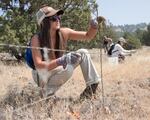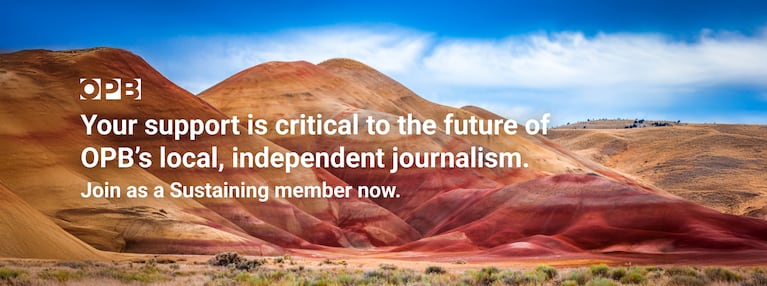
ONDA volunteer Ellysa Lindenmaier removing fence on Steens Mountain in Oregon in 2017.
Sage Brown/Courtesy of ONDA / Sage Brown
Some of Oregon’s public lands feature obsolete fencing that’s damaged and harmful to animals. The Oregon Natural Desert Association has been working on removing fencing from public grounds for years. In 2012, the association completed an effort to remove barbed wire fencing from the Hart Mountain National Antelope Refuge in Lakeview. Since then, the organization has continued removal efforts in the state and also works on building and retrofitting fencing to protect wildlife. The organization has partnered with the Bureau of Land Management on some of this work. Lace Thornberg is the communications manager at the association and Kate Yates is a wildlife biologist for BLM. They join us with details.
Note: The following transcript was created by a computer and edited by a volunteer.
Dave Miller: This is Think Out Loud on OPB. I’m Dave Miller. We end today with fences. Good fences make good neighbors, says a character in a famous poem by Robert Frost. But what about bad fences or obsolete ones – barbed wire that no longer keeps cows in or out, but instead just snags Pronghorn. These are the kinds of fences that ONDA, the Oregon Natural Desert Association, has been focusing on for a number of years now, either removing or retrofitting them. In other places, they’re actually building new fences. Lace Thornberg is the communications manager at ONDA. Kate Yates is a wildlife biologist with the Bureau of Land Management. They both join us to talk about fences, good and bad. Welcome to the show.
Kate Yates: Thank you.
Lace Thornberg: Hello, hello.
Miller: Lace Thornberg, first. Can you give us a sense for the scale of what we’re talking about? How much fencing is there in the U.S. West right now?
Thornberg: Sure. This is interesting for people who may be new to the West, might not have thought about this issue before, you might be surprised to know that researchers at UC Berkeley have found that the American West could hold up to 620,000 miles of roadside and pasture fences and that is enough to circle the globe 25 times.
Miller: And that would be on both public and private land?
Thornberg: Yes.
Miller: Was all of this fencing put up to keep cows or sheep inside a particular area or outside a particular area?
Thornberg: Yeah, I mean, I think fences are going to be put up for a variety of different reasons, maybe to delineate private property or as you mentioned for grazing patterns. And I think one thing that we’re really interested in looking at here is how, even though those land ownerships might change over time and the uses of those lands might change over time, the fences have generally been left up.
Miller: Do you have a sense for … I mean, 620,000 miles I think is what you said. But do you have an estimate for the percentage of that that is no longer being actively used and it’s just sort of vestigial fencing that no one had the time or energy or desire to get rid of?
Thornberg: I don’t have the American West numbers. I can tell you about, in the greater Hart-Sheldon area specifically, which is in Oregon, which is about two million acres just south of Lakeview, Oregon. This is an area that has wildlife refuges on either side. And the U.S. Geological study has found that there’s 625 miles of fence in that area. And then of that work, we’re looking at our volunteers right now have identified over 100 miles of fence in that land between Hart Mountain and Sheldon National Wildlife Refuge that needs to be retrofitted to be made more wildlife friendly.
Miller: Kate Yates, why is this a problem? What’s wrong with fences that are left in various parts of the West?
Yates: Well, fences can pose risks to wildlife in various ways. The first thing that comes to mind obviously is the direct injury to individual animals as they either crawl under or jump over a fence that has loose wire, loose barbed wires and such. They can become entangled and suffer for long periods of time before eventually succumbing to their injuries. And other injuries that they’ll move on, but they can become infected. And that we also have to think about the other risks that they pose in a different way. So it can change the behavior of herds of big game if they’re unable to, or it’s difficult for them to go about their seasonal movement patterns, their migration, and so it can force them to find alternative routes, expending more energy or spending time in a suboptimal area. And this ultimately is going to affect the viability of a population.
Miller: Which species are most affected by the different effects we’re just talking about, either getting snagged and potentially caught or cut by barbed wire or the inability to, say, go to a favorite stream or to migrate in the way they naturally would. Which species are we talking about?
Yates: Well, here in the Lakeview field office, we have … I mean the whole area is broadly big game habitat for mule deer, elk, bighorn sheep and pronghorn and all these species need to move to different areas periodically to meet their needs. And pronghorn, they’re kind of a special animal. It’s not that they’re not physically capable of jumping a fence, but they definitely prefer to crawl under, some individuals are completely adverse to jumping over, and if a herd of pronghorn, they need to be able to smoothly crawl and run under fences to get to where they’re going. But yeah, these fences can pose risks to all of our big game species.
Miller: Lace Thornberg, what does retrofitting a fence mean?
Thornberg: Good question. So retrofitting is a pretty straightforward solution that makes a really important life and death difference for these wild animals. So in places where a fence is still needed, volunteers will take and replace the bottom strand of, maybe a typically three strand barbed wire fence, they’ll replace that bottom strand with smooth wire instead of barbed wire. And that’s gonna let those pronghorn and others, like young mule deer or elk, crawl under the fence without injuring themselves by catching themselves on that bottom wire.
Miller: That’s in a place where you said you’d want to keep the fence there for some reason. That would be because a private landowner or rancher with a lease still needs a fence for some reason?
Thornberg: Sure, yes.
Miller: And there are other places, I understand, where your teams of volunteers are actually removing fences. How do you decide where you can do that?
Thornberg: That’s looking in coordination with the land manager. So, we’d be working with Kate at the BLM and other land managers to see what those uses on the landscape are. And in places where … like on the Hart Mountain National Wildlife Refuge, there isn’t any grazing. That’s a place where that’s an easy go-ahead to remove all the fencing. And in fact, our volunteers have done that. They’ve pulled out more than 300 miles of fences on Hart Mountain and they’re completely done with that effort.
Miller: Kate Yates, how would you describe this relationship, this partnership between the BLM and the Oregon Natural Desert Association, with respect to either removing or retrofitting fences?
Yates: Oh, I believe this is a very valuable partnership. So not only is ONDA recruiting volunteers to do events – on the ground events – to help us repair and modify fences, but they’ve also recruited volunteers to inventory many, many miles of fence. And I guess from my perspective, this is probably the most valuable to us here at the BLM because it’s gonna help us identify where that work is needed so we can put more miles of work either under contract or plan to do that in-house. So yes, I just can’t speak highly enough of ONDA and their help with this project.
Miller: Lace Thornberg, we just have about a minute left. But my understanding is in other places, you’re actually building fences. What are places where you’re doing that?
Thornberg: In one place that we’re working on is along the South Fork Crooked River near Prineville. This is part of a large-scale multi-year effort to improve the habitat through that entire Southfork wilderness study area. And there we are wanting to do some more habitat restoration along the river. But we need to keep the, we can’t plant anything along the river unless we can keep animals out that would be grazing on that before those plants are established. So that’s where we would be building fences. And we actually have a project that’s starting in a couple of days if people want to sign up for it on September 30.
Miller: Lace Thornberg and Kate Yates, thanks very much.
Yates: Thank you.
Thornberg: Thank you.
Miller: Kate Yates is a wildlife biologist with the BLM, the Bureau of Land Management. Lace Thornberg is communications Manager at ONDA, the Oregon Natural Desert Association.
Contact “Think Out Loud®”
If you’d like to comment on any of the topics in this show, or suggest a topic of your own, please get in touch with us on Facebook or Twitter, send an email to thinkoutloud@opb.org, or you can leave a voicemail for us at 503-293-1983. The call-in phone number during the noon hour is 888-665-5865.

